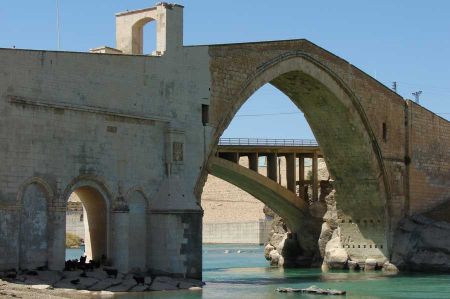Batman Bridge on the reservoir - the Malabadi Bridge
- Written by Portal Editor
Every country, including Turkey, needs energy in the form of electricity in immense amounts.
If hydropower is used instead of fossil fuels or even atomic energy, environmentally conscious citizens should be satisfied, right? There are, however, regions that should actually prohibit the damming of water in dams if cultural assets disappear parallel to the damming up of the water. Not just since the flooding of the ancient sites in Hasankeyf did a major construction site become a political issue and ultimately lead to a huge dispute.
There were similar discussions with the beginning of the dam project on the Batman River, where it was about the historical, but medieval bridge Malabadi Köprüsü, called Pira Malabadê by the predominantly Kurdish population there. The Malabadi Bridge is an arch bridge over the Batman River near the town of Silvan in southeastern Turkey. Construction work began as early as 1146/1147 during the Artuqid period and was apparently completed in 1154/1155.
According to the local historian Ibn al-Azraq al-Farīqī from the 12th century, the bridge of its time replaced a bridge built in 668/669, which collapsed shortly before it was rebuilt. However, inconsistencies between the two surviving manuscript copies of Ibn al-Azraq's report make it difficult to definitively identify the Malabadi Bridge as what he calls the Qaramān or Aqramān Bridge. However, many aspects of its geographical description and historical record support this identification.
Solid wood as a support structure for the arch
After the builder Al-Zāhid had built the eastern foundation of the bridge, it was destroyed by floods. Al-Zāhid was punished for "poor craftsmanship" and replaced by Amir Saif al-Dīn Shīrbārīk Maudūd bin ʿAlī bin Artuq. Shīrbārīk resumed the work under the supervision of Abuʾl-Khair bin al-Ḥakīm al-Fāsūl, who used solid wood in the construction. With the turn of the year 1153/1154 the bridge was almost finished. And yet, at the time of the death of Ḥusām al-Dīn Temür-Tash on January 18, 1154, the arch was not yet completed. His successor, Najm al-Dīn Alpī, set about completing the bridge, and although the work was again interrupted by flooding, "he built and repaired it and completed the connection of the arch."
Architectural historian Albert Gabriel & epigrapher Jean Sauvaget
 The French architectural historian Albert Gabriel and the epigrapher Jean Sauvaget visited the bridge in 1932 and Sauvaget recognized an inscription in the name of Temür-Tash with the year 1147/1148, which possibly corresponds to the beginning of the second construction under Shīrbārīk.
The French architectural historian Albert Gabriel and the epigrapher Jean Sauvaget visited the bridge in 1932 and Sauvaget recognized an inscription in the name of Temür-Tash with the year 1147/1148, which possibly corresponds to the beginning of the second construction under Shīrbārīk.
The bridge was restored in the late twelfth century and more recently in the early 20th century. It was once the only bridge over the river in the area and was in continuous use until the 1950s when a new road bridge was opened upstream.
The span of the bridge is perpendicular to the river, but the roadway is at an angle to the river so that there are angle breaks in the east and west approaches. The approaches rise from the bottom and meet the central span, which is a pointed arch high above the deepest part of the river. The approaches consist of colored solid masonry and are provided with small arches to let the flood through. Two of the bridge's pillars sit in the river; The western support is decorated with two carved figures, one standing and one seated. The bridge is 150 m long and 7 m wide, 19 m high and has a main span of 38.6 m. The roadway has two toll booths, one on either side of the main span. The gussets of the main arch contain small spaces for weary travelers.
In 2016, it was added to the tentative list of World Heritage Sites in Turkey, which helped protect the bridge. The view of the monumental structure was almost completely obscured by the dam.
Please read as well:
Hiking - The stone arch bridges in Pindos Mountains
Struga - shoeshine and bridge jumper at the Black Drin
